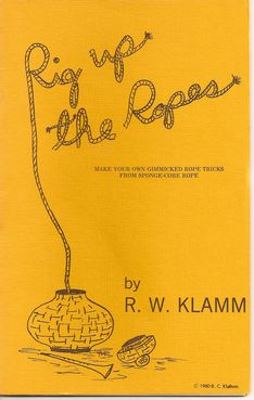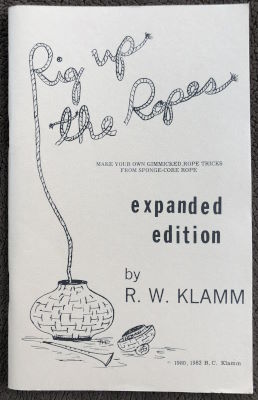©1980 B.C. Klamm, Klamm The Magic Man, MO
Softcover, saddle-stitched, 5.5x8.5", 30 pages
Expanded Edition
©1982 R.C. Klamm
Softcover, saddle-stitched, 5.5x8.5", 54 pages

Image from Magicref

Image courtesy Don's Magic and Books
| Klamm, R.W.: Rig
Up the Ropes ©1980 B.C. Klamm, Klamm The Magic Man, MO Softcover, saddle-stitched, 5.5x8.5", 30 pages Expanded Edition ©1982 R.C. Klamm Softcover, saddle-stitched, 5.5x8.5", 54 pages |
 Image from Magicref |
 Image courtesy Don's Magic and Books |
Comments: This is a decent coverage of some gimmicked rope tricks. The lack of illustrations makes some of the effects a little more difficult to understand.
Contents: (From expanded edition - updated Jun 2023)
Note: Items with * are added from the original edition
1 Why Use Sponge-Core Rope? advantages of the rope and answers to
objections
4 Finishing Ends: various end finishes described such as the
Knotted End, The Shoestring End, Binding, Flush End, Hollow End
9 Stripping Out the Sponge Core: how to do it
11 Making the Sleeve-Threader: making a tool to thread another
object through a hollow rope sleeve
13 Mounting Magnets and Rope Gimmicks: how to do it
14 Splicing
15 *The Sliding Knot
17 *The Rope Winder: including several tricks
22 *Stretch-A-Rainbow Ropes
25 Four Ended Rope Routine (Geoffrey Buckingham): a rope is looped
through the hands and a third, then a fourth end appears. The rope
ends up with only two ends.
29 White Christmas
32 *Colorful Cowboy
36 *The Witch Burning
39 Color Changing Rope: the principle, the manufacture, and the
performance
43 Tri-Color Nightmare: a brief version of the Professor's
Nightmare with a color change
45 *Lots A Knotts
47 Rainbow Ropes (Standard Version): Three different colored ropes
are shown tied together. They are untied at one end, making a
chain of three. They are rolled around the hand and unrolled, and
the knots have disappeared.
49 Scotchman's Choice Cut and Restored Rope: a rope is cut with
invisible scissors, but the cut ends are shown. The cut ends are
tied, then the knot is slid to the end where it is untied, leaving
a long and a short rope.
51 Tri-Color Linking Ropes: Spectator ties three different colored
ropes into loops. The ropes are linked and unlinked by the
magician. Manufacture and performance are described